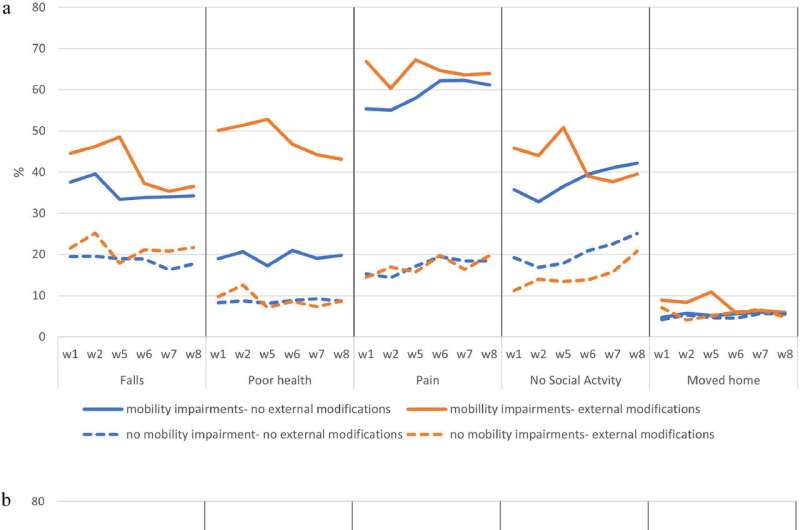Poorer health in disabled linked to lack of home adaptations

Older people with mobility problems living without home adaptations have poorer health and higher levels of pain, according to researchers at The Universities of Manchester and Hong Kong.
The study of English data, published today in The Lancet Regional Health Europe also links the lack of adaptations to not being able to participate in social activities and having to move home within two years.
The analysis followed over 10,000 adults aged 60 and over living at home in England for an average of 11 years using data from the English Longitudinal Study of Aging.
The team compared older adults with and without mobility impairments living in homes that had been accommodated to their disability or that had remained unadjusted.
Among those with severe mobility impairments, home adaptions reduced the probability of falls by 3%, pain by 6%, and poor health by 4% compared to disabled adults coping without help.
Modifications for external access also increased the chances that people could go out of their home and participate in social life by 6% and enabled them to remain in their home for at least the next two years by 4%.
The adaptions they studied include widened doorways, access ramps, automatic doors, accessible parking, handrails and bathroom or kitchen modifications.
Lead author Honorary Professor Tarani Chandola from The University of Manchester said: "Mobility impairment is the most prevalent form of disability facing older adults today and includes difficulty in walking, climbing stairs, and getting up after sitting.
"But most of the housing stock in the U.K. is poorly designed for a rapidly aging population, with only 7% of homes in England in 2014 meeting the minimum standard of accessibility.
"Over 70% of older adults with a mobility impairment in England live in a home without an accommodation for their disability."
Participants in the survey were asked if their homes had external modifications such as widened doorways, ramps, automatic doors, parking and a lift and internal modifications such as rails, bathroom/kitchen modifications and a chair lift.
Mobility impairment was measured through reported difficulties in 10 activities including walking, climbing, getting up, reaching and lifting.
Five disability outcomes were analyzed: falls in the previous two years, pain, poor self-rated health, no social activities, and moving home within next two years.
Until now, medical researchers often bundled up housing modifications with clinical or non-clinical interventions such as advice from a physiotherapist or exercise therapy, making it hard to separate the specific effect of home adaptations.
But thanks to the study, the team has been able to make a compelling case for additional investment in such home adaptations by policy makers.
He added: "Our study highlights how this topic has received little attention in debates about health and social care services.
"We now have strong and consistent evidence that housing adaptations can prevent a deterioration in the health, well-being, and quality of life of disabled older adults. That is why improving the quality of our housing is essential for achieving healthy aging in the community."
More information: Tarani Chandola et al, Home modifications and disability outcomes: A longitudinal study of older adults living in England, The Lancet Regional Health—Europe (2022). DOI: 10.1016/j.lanepe.2022.100397



















